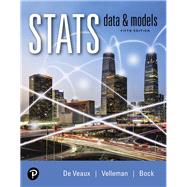NOTE: This loose-leaf, three-hole punched version of the textbook gives you the flexibility to take only what you need to class and add your own notes – all at an affordable price. For loose-leaf editions that include MyLab™ or Mastering™, several versions may exist for each title and registrations are not transferable. You may need a Course ID, provided by your instructor, to register for and use MyLab or Mastering products.
For courses in Introductory Statistics.
Encourages statistical thinking using technology, innovative methods, and a sense of humor
Inspired by the 2016 GAISE Report revision, Stats: Data and Models, 5th Edition by De Veaux/Velleman/Bock uses innovative strategies to help students think critically about data – while maintaining the book’s core concepts, coverage, and most importantly, readability.
By using technology and simulations to demonstrate variability at critical points throughout the course, the authors make it easier for instructors to teach and for students to understand more complicated statistical concepts later in the course (such as the Central Limit Theorem). In addition, students get more exposure to large data sets and multivariate thinking, which better prepares them to be critical consumers of statistics in the 21st century.
The 5th Edition’s approach to teaching Stats: Data and Models is revolutionary, yet it retains the book's lively tone and hallmark pedagogical features such as its Think/Show/Tell Step-by-Step Examples.
Also available with MyLab Statistics
MyLab™ Statistics is the teaching and learning platform that empowers instructors to reach every student. By combining trusted author content with digital tools and a flexible platform, MyLab Statistics personalizes the learning experience and improves results for each student. With MyLab Statistics and StatCrunch, an integrated web-based statistical software program, students learn the skills they need to interact with data in the real world.
Note: You are purchasing a standalone product; MyLab Statistics does not come packaged with this content. Students, if interested in purchasing this title with MyLab Statistics, ask your instructor to confirm the correct package ISBN and Course ID. Instructors, contact your Pearson representative for more information.
If you would like to purchase both the physical text and MyLab Statistics, search for:
0135307996 / 9780135307991 Stats: Data and Models, Loose-Leaf Edition Plus MyLab Statistics with Pearson eText - Access Card Package
Package consists of:
- 0135163838 / 9780135163832 Stats: Data and Models, Loose-Leaf Edition
- 0135189691 / 9780135189696 MyLab Statistics with Pearson eText - Standalone Access Card - for Stats: Data and Models










